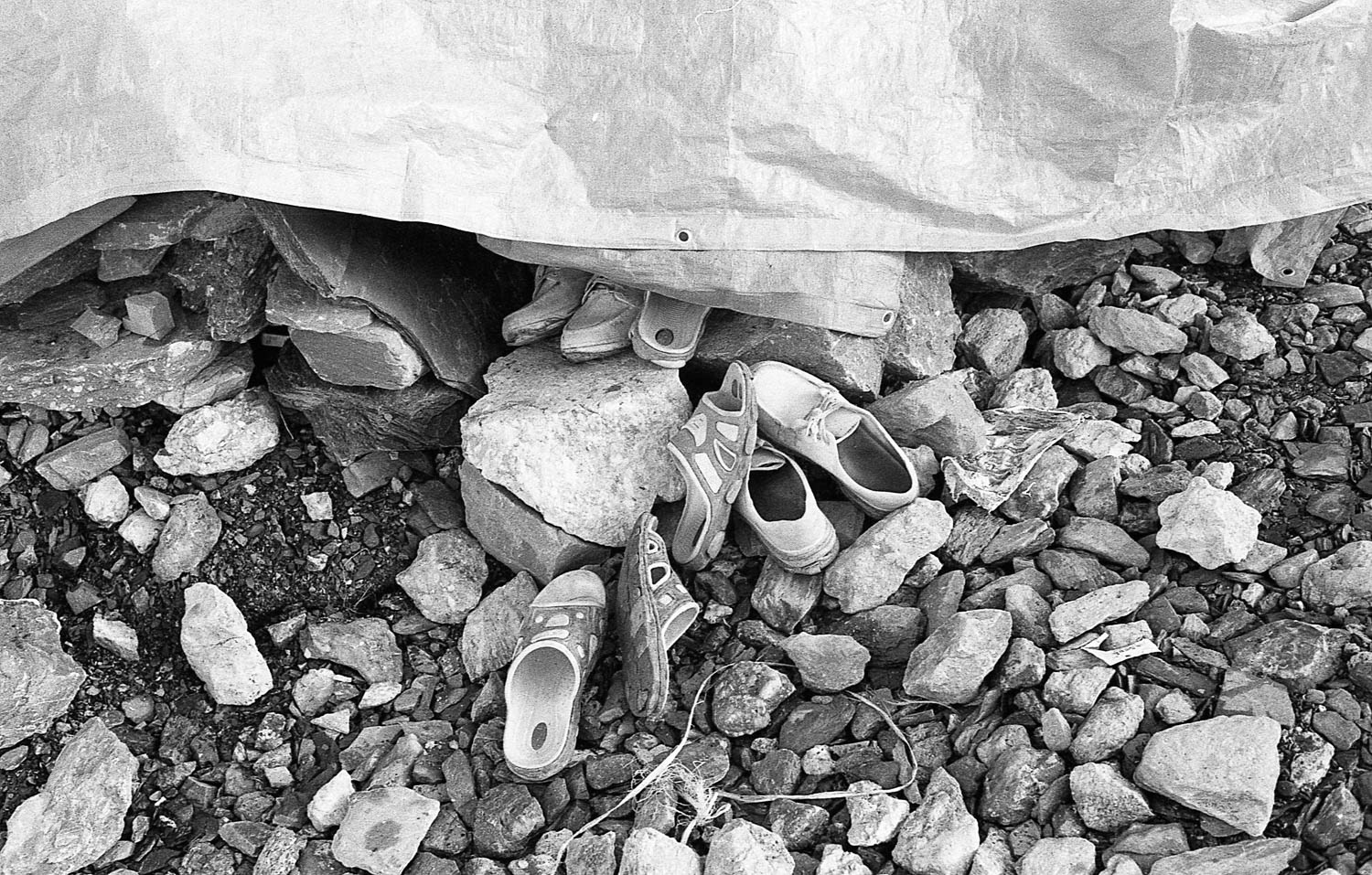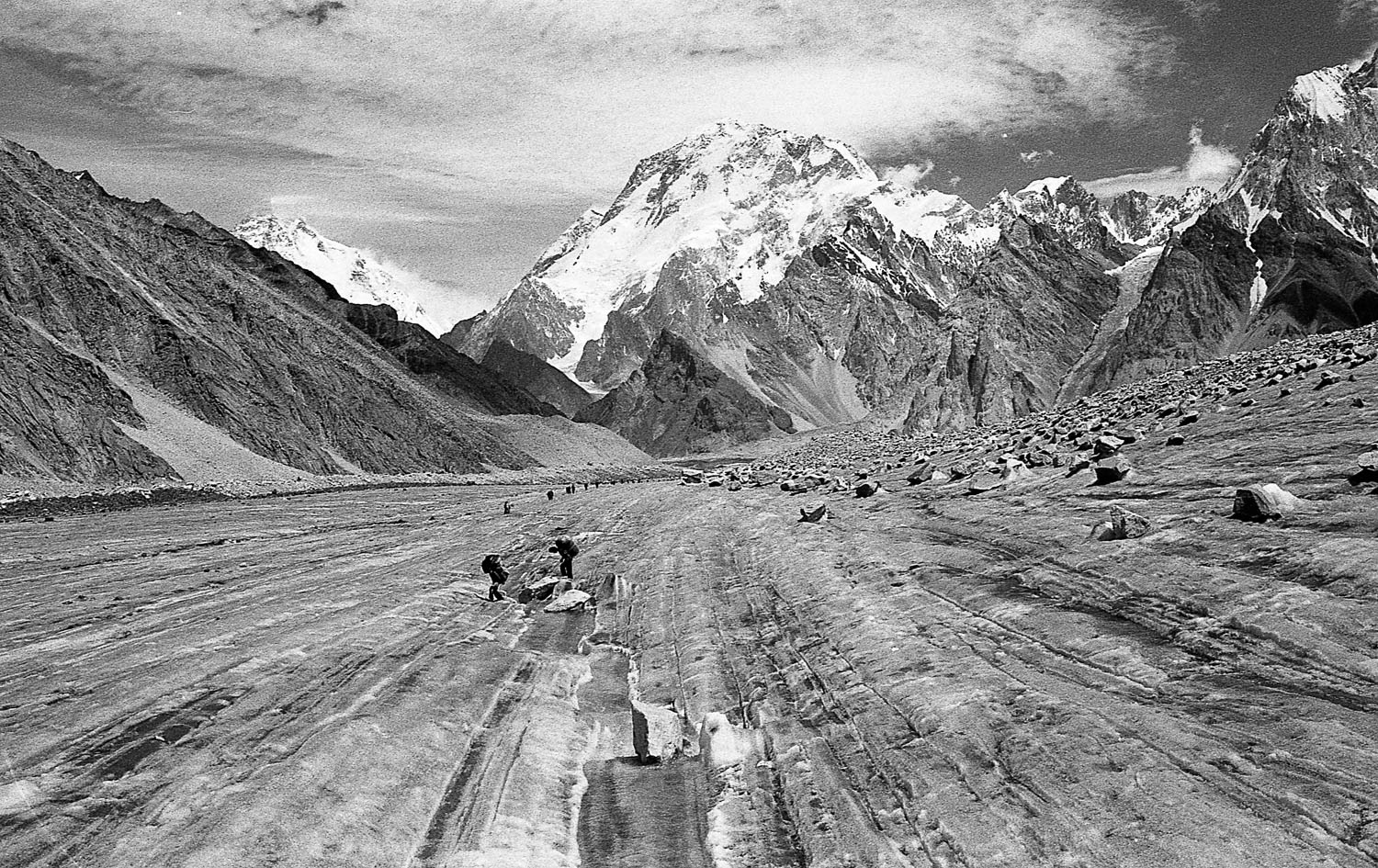
The village of Askole, from where all Karakoram expeditions starts, remains unchanged in appearance for over a century.

While trekkers and mountaineers reach their starting point comfortably by jeep, high-altitude porters, on the other hand, rely solely on their own two feet or, if fortune permits, sitting on a jeep's roof to make their way to the starting point.

With the previous bridge swept away by the relentless Braldu river, porter crosses a temporary bridge.

In the early days of a trek, porters must shoulder a heavy load, over 25 kilograms of equipment along with their personal belongings and food.

After two days of traversing a rugged yet somewhat navigable terrain, the path suddenly transforms into a treacherous glacier, that makes the journey very dangerous.

Porters construct simple shelters using polyethylene film and stones, as carrying personal tents would add additional weight to their already heavy loads. However, the primary reason why they don't using tents is due to financial constraints, they simply can't afford it.

During their stay at the campsites, porters showsr their sociable nature, frequently engaging in games and folk singing. However, occasional fights can also break out amongst them.

The trek is divided into several stages, typically from one campsite to the next, with the porters being paid per stage. Each stage has a predetermined fixed rate, which varies depending on the distance and altitude of the route.

Within the porter community, there exists two distinct groups: those who are solely responsible for carrying the loads, and those who additionally provide support to the local expedition staff by pitching tents, aiding in the kitchen, and performing other miscellaneous tasks.

While those who assist the expedition staff typically receive a slightly higher salary, their workload is also considerably more demanding. Beginning their day a few hours before sunrise, they continue to work late into the night, hours after the caravan arrives at the campsite.

During high season, there may be several concurrent expeditions taking place. Since all groups stay at the same designated campsites, it's not uncommon for the campsites to become crowded, with up to a hundred people occupying the area.

Since the porters are required to carry their own food, their meals tend to be very simple, often consisting of just chapati with plain sour and little else.

At altitudes above 4000 meters above sea level, expedition leaders typically provide the porters with meat, usually in the form of chicken or goat that have been walked up on foot, as it's not possible to carry frozen meat for more than a week. This meat is often the leftovers from the tourists' meals that they have not eaten.

Concordia is where the Baltoro Glacier meets the Godwin-Austen Glacier, and it is usual for expeditions to spend a few days there for acclimatization.

One of the most scenic places on the trek is Concordia, as it offers views of K2.

In the trek, mules are used to carry some of the cargo. However, they are unable to continue beyond Concordia as the terrain becomes too rough.

The equipment used by the porters is simple, like this self-made frames for carrying loads.

In some instances, tourists may gift porters with high-quality equipment, such as trekking shoes, etc. However, most porters prefer to sell the equipment and continue using basic items like flip-flops or cheap rubber shoes. Only the higher-ranking members of the expedition staff use mountaineering gear.

Despite often being separated from tourists due to language barriers, porters are warm and welcoming individuals who are always ready to share a cup of chai with anyone.

The stretch of the trail between Concordia and Ali Camp is particularly scenic, with the imposing peaks of K2 and Broad Peak forming a striking backdrop.

In most cases, glaciers appear to be mounds of rocks, but the Upper Baltoro between Concordia and Ali Camp is covered entirely in snow and ice.

The ascent to Gondogoro La pass, which stands at an altitude of 5585 meters above sea level, marks the most challenging segment of the trek, commencing after Ali Camp.

To prepare for the climb up Gondogoro La pass, porters creates improvised crampons by attaching pieces of rubber foam to their soles.

The expedition leader admonished a porter from our team who had refused to ascend Gondogoro La pass. Porters are a group that is difficult to manage and regulate, and strikes are a common occurrence. In his book about the first K2 ascent, even Ardito Desio describes multiple instances of local porter strikes. This time was no different, as porters from one group refused to climb Gondogoro La pass. The refusal of one group of porters actually forced others to refuse as well, as there was no way to influence them, and all expeditions had to turn around.

One had no choice but to retrace the steps and walk back for several days to return to Ascole village.

In an effort to preserve the environment, the locals take measures to remove some of the garbage from the glacier, while the rest is disposed by being burned locally.

The farewell dinner upon returning from the expedition is the only occasion when both porters and tourists gather around the same table.



































